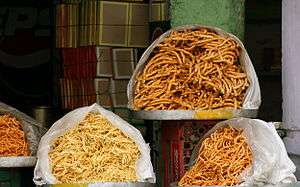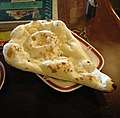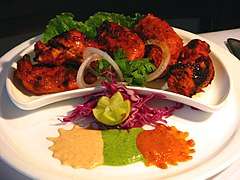Bikaneri bhujia
Bikaneri bhujia, often simply called bhujia, is a popular crispy snack prepared by using moth beans and besan (gram flour) and spices, originating from Bikaner, a city in the western state of Rajasthan in India. Light yellow in colour, it has become not just a characteristic product of Bikaner, but also a generic name.[1] Each variety prepared by large scale manufacturers also go through a rigorous testing procedure. This ensures that every new variety though mixed with different ingredients does not lose its basic nature.
 Shop selling Bikaneri bhujia | |
| Alternative names | Bhujia |
|---|---|
| Course | Snack, starter |
| Place of origin | India |
| Region or state | Bikaner (Rajasthan) |
| Main ingredients | Moth bean, besan, groundnut oil |
| Variations | Sev |
Bikaneri bhujia has been a cottage industry in Bikaner, Rajasthan, and provides employment to around 2.5 million people in villages of the region, especially women, and recently it has faced competition with multinational companies like Pepsico as well as Indian snack companies, which have used the name bhujia.[2][3] After struggling with numerous copycats over the years, in September 2010, the Indian Patent Office confirmed the Geographical Indications rights and a patent was issued for the brand name Bikaneri bhujia to local manufacturers of Bikaner.[4][5][6]
History
In 1877, during the reign of Maharaja Shri Dungar Singh, the first batch of bhujia was produced in the princely state of Bikaner.[7]
Preparation
A dough of moth dal besan and spices including chana dal, powdered cellulose (fiber), salt, red chilli, black pepper, cardamom, cloves, groundnut oil, etc. is formed into the snack by pressing it through a sieve and deep frying in vegetable oil. Not only in the city but in the whole country, especially, in Rajasthan, Gujarat, Maharashtra, Bihar and in West Bengal it is a must served item with the regular food.
Geographical Indication protection
In September 2010, Bikaneri bhujia was granted Geographical Indication protection.[8] Getting the GI tag will ensure that none other than those registered as authorized users (or at most those residing inside the geographic territory) are allowed to use the popular product name, an assurance of distinctiveness in a land of thousand cultures.
See also
References
- "Camel country: Known for its sand dunes and bhujia, Bikaner". The Tribune. 18 January 2009.
- "The whole world's bhujia". indiatogether.org. 26 July 2005.
- "India: TNCs muscling into cottage industry sectors". TWN (Third World Network). 11 January 1996. Archived from the original on 27 September 2011.
- "A copyright for Bikaneri bhujia, Hyderbadi haleem". Indian Express. 14 September 2010.
- "Registered Geographical Indications (GI)" (PDF). Geographical Indication Registry (India). Archived from the original (PDF) on 4 February 2011. Retrieved 5 March 2011.
- "Patent shield soon from copycat GI Joes". Economic Times. 24 February 2007.
- http://www.thehindu.com/features/metroplus/Food/in-search-of-bikaneri-bhujia/article3945487.ece
- A copyright for Bikaneri bhujia, The list has grown from 120 to 132, adding Bikaneri bhujia from Rajasthan.


